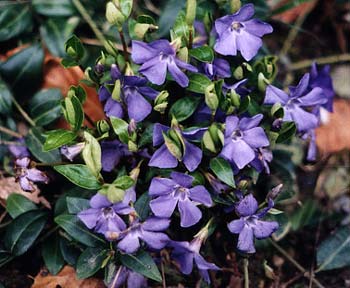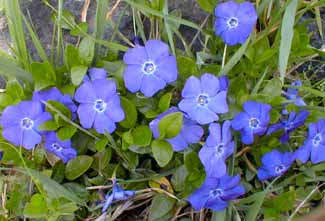 | |
| Though in general a shade-loving plant, this is an early Spring photo of the end of a row of periwinkle planted a year earlier in morning to noon sun, & it is doing just fine. It is perhaps less aggressive in sun than in the shade, but happily adapts to whatever one does to it. | |
The War of the Periwinkle
"In shady shrubby places,
Right early in the year,
I lift my flowers' faces --
O come & find them here!
My stems are thin & straying,
With leaves of glossy sheen,
The bare brown earth arraying,
For they are ever-green.
No great renown have I. Yet who
does not love Perwinkles blue?"
-Cicely Mary Barker
1895-1973
1895-1973
The common periwinkle, Vinca minor, is a vining groundcover, & moderately invasive. But we had some that went beyond moderation. A row of shrubs had such a thick carpet of vinca beneath that it was actually beginning to choke off water & nutrients to the shrubs, & was humping up higher & higher until trunks of shrubs completely disappeared. I had tried for a couple years to restrain its spread by clipping & ripping, but the act of fertilizing the larger plants just made the vinca tougher & more aggressive until in some areas it was well over a foot thick with its extremely tough wiry vines. Even weeds could not share any of its space.
One struggling shrub I had been worrying about I originally thought was being too shaded by the more overbearing shrubs to its left & right, so I tried to dig it up to move to a location it could have to itself. It was then that I discovered how massively thick the vinca root system had become, like a dense brick of wiry roots as thin & tough as the vines themselves. Anything that didn't have its own roots well below the vinca rootline was just doomed. Large shrubs could hold their own, & a few hardy bulbs poked their leaves up in season, but that was it. These roots were able to dry out & harden the ground so rapidly even deeply rooted plants weren't getting their share of water & nutrients.
 Now I wouldn't want to frighten people away from vinca. Most of the fancified cultivars would never get this bad, & even the most aggressive natural forms would have to find conditions unusually inviting to get this carried away with themselves. Vincas with variegated leaves, or with magenta or white flowers instead of the wild violet-blue, ought to be more easily controled. But given the right conditions & passage of enough years of letting vinca grow unchecked, it can become the troublemaker I'd inherited from the previous owners.
Now I wouldn't want to frighten people away from vinca. Most of the fancified cultivars would never get this bad, & even the most aggressive natural forms would have to find conditions unusually inviting to get this carried away with themselves. Vincas with variegated leaves, or with magenta or white flowers instead of the wild violet-blue, ought to be more easily controled. But given the right conditions & passage of enough years of letting vinca grow unchecked, it can become the troublemaker I'd inherited from the previous owners.I liked such a thick flowering carpet of evergreen vines, so it was a hard decision to make, & removing it was an even harder task once the decision was made. It was difficult even to pick-axe the hardened ground. So I would wait until after a very good rain which softened it up a bit, then I would struggle to dig up a two foot by two foot patch at a time, tossing the stripped mats up on the roadside where if it lived or died didn't matter (it lived).
As I bared more & more of the soil, it was funny to see all the old plant-tags that were hidden by the vinca. The previous owners had evidently planted lots more than vinca along there, but over time everything that wasn't a big tough shrub was obliterated.
Because it was so hard to pull up small mats of it, I would only struggle with it a couple times a week, loosening around the edges one day, shoveling beneath the edges another day, slowly working my way up the row under the shrubs. Eventually it was mostly removed, though bits of it would continue to pop up & be weeded out forever after.
Despite this struggle, I actually do like periwinkle, & ended up planting the regular purple & the violet V. minor'Atropurpurea' side-by-side between the sump pump & a flagstone path, where if it ever becomes that dense & wild, that'd be okay, there's nothing it would be competing with for moisture. Even out of season, at the height of winter, the vinca sends up random flowers. It is intensely evergreen & very undemanding. I doubt I would ever plant it alongside other small plants, as very little could out-compete it over time; but given a little spot of its own, it is winning stuff. The sump pump at its back, & foot traffic along the path, mostly keeps it from spreading where unwanted.
Vinca grew throughout the Roman world, as they brought the plant with them into regions of Roman conquest. Many of the tales of maenads or bacchantes bedecked in ivy probably regard vinca, especially when worn during rituals of death. The association of vinca with death is most ancient, worn as wreathes by human sacrifices, which tradition lingered well into the Middle Ages when vinca was used to garland criminals to be hung from scaffolds until dead. Simon Fraser, the follower of the Scottish hero William Wallace, was in 1306 led in irons through the streets of London enroute to execution, with a garland of vinca on his head. The ancient association of vinca with death in Italy was preserved in a tradition of weaving vinca garlands for dead infants, while in France it was known as "the Violet of Sorceries."
Its name used to be Pervinca or Pervinkle, with sundry other spellings & permutations, having Latin root indicating a band or wreath. This was in time corrupted into Periwinkle, though there is no resemblance to the sea snail. The "band" of periwinkle was a spiritual as well as a literal wreath, & Culpepper records an old tradition that if a man & woman eat vinca together, they will be forever bonded in love, a last echo of vinca's fertility association with the Great Mother, goddess both of death & birth.
Compare the little Vinca minor to
Vinca major
which is believed to have originated in the wild
perhaps millenia ago as a sport of V. minor.
And also see the variegated forms of the large
Vinca major 'Maculata'
& the little
Vinca minor 'Illumination'
Vinca major
which is believed to have originated in the wild
perhaps millenia ago as a sport of V. minor.
And also see the variegated forms of the large
Vinca major 'Maculata'
& the little
Vinca minor 'Illumination'